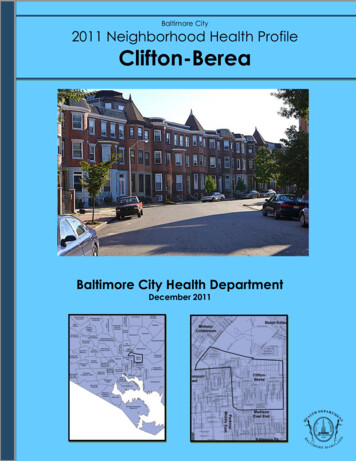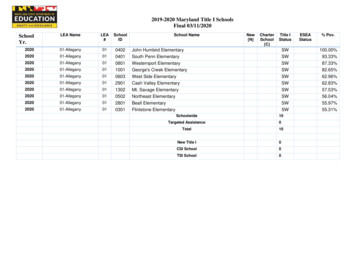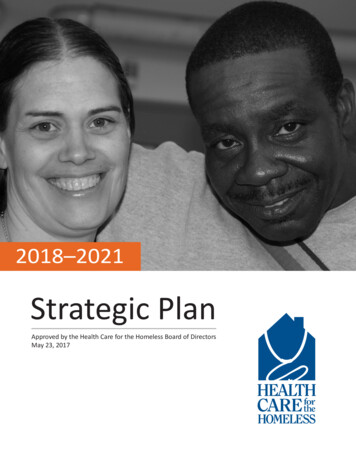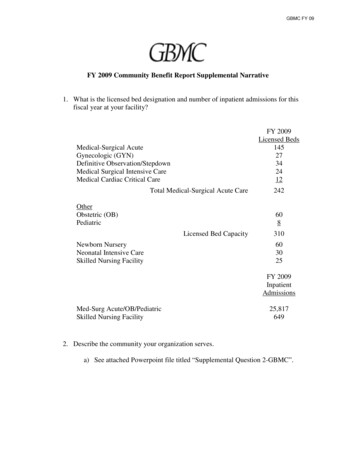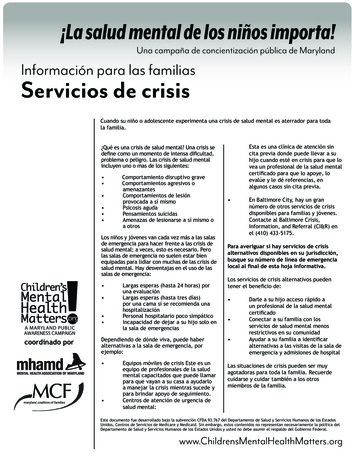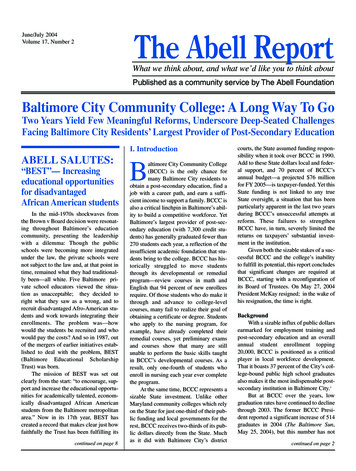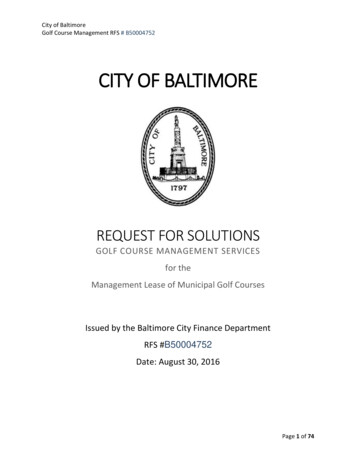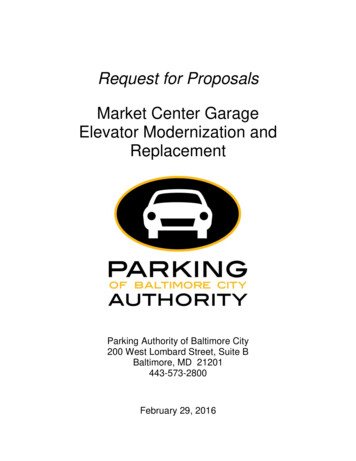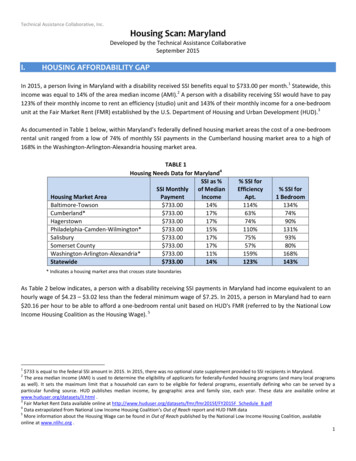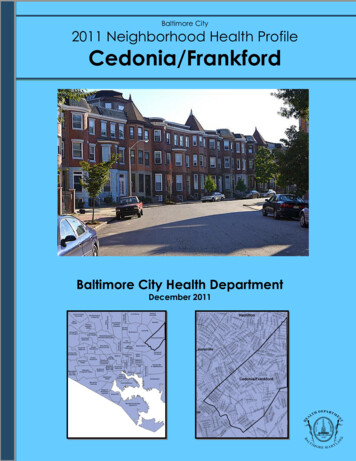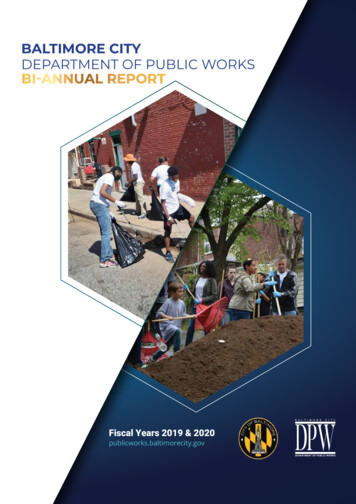
Transcription
BALTIMORE CITYDEPARTMENT OF PUBLIC WORKSFiscal Years 2019 & 2020publicworks.baltimorecity.gov
BALTIMORE’SOUR MISSIONDEPARTMENT OF PUBLIC WORKSWe support the health, environment, andeconomy of Baltimore City and the region byproviding customers with safe drinking waterand keeping neighborhoods and waterwaysclean.OUR VISIONTo be a strong proponent and protector ofour environment and the health and vitalityof our communities.
DPW BI-ANNUAL REPORTCONTENTSMAYOR’S MESSAGE2DIRECTOR’S MESSAGE3BUREAUS, DIVISIONS & OFFICES4EQUITY & ENVIRONMENTAL JUSTICE8DPW BY THE NUMBERS9FACING BIG CHALLENGES12SMITHSONIAN WATERWAYS14WATER AFFORDABILITY15DRINKING WATER AND INFRASTRUCTURE PROTECTION16CLEANING THE CITY18DPW IN THE COMMUNITY23AWARDS AND RECOGNITIONS27LOOKING AHEAD: THE FUTURE29FY 2019 & FY 2020 Bi-Annual Report 1
MAYOR’S MESSAGEBaltimore has endured! We fought hard and beat backthe British attack in 1814. If we had not won on thatSeptember day there might not be a United Statesof America. We endured the Civil War with an almostevenly divided population supporting either side. Thefirst blood of that war was shed on April 19, 1861 onPratt Street. We endured the Great Baltimore Fire of1904 and rebuilt our city stronger than before. Weendured the Flu Pandemic of 1918 and numerousuprisings and civil unrest. Our shipyards and steel millsserved as arsenals of democracy in two World Wars,and we endured.Today, we face a horrendous pandemic, yet we stillare moving forward, and even taking a leadership role in the battle againstCOVID-19. We have some of the finest medical research institutions in theworld, and the science and service from those who work there will hopefullyenable us to not only endure, but also to thrive.As we think about our first responders, let us not forget our Baltimore CityDepartment of Public Works (DPW) employees. Trash does not collect itself.Neither does recycling. Handling contaminated items is always an unpleasantduty. During a pandemic it is fraught with extra dangers.Employees continued to provide water throughout the pandemic. They fixed thebroken mains. They continued moving forward on major capital infrastructureprograms. They purified our wastewater. They protected our watersheds.Last year, Baltimore weathered a cyber-attack, and we had a sudden change inleadership. We put a new focus on crime and grime, and we are moving forwardon new fronts to address both. Housing is improving, and abandoned buildingsare being demolished.One constant is the Baltimore City Department of Public Works. It’s commitmentto fighting grime is stronger than ever. In addition to the regular trash, recycling,and bulk collections, over the last two years DPW has expanded comprehensivestreet-sweeping, provided municipal trash cans to each house, Smart Cans forlitter control on hundreds of street corners, and developed a proactive approachto battling rats. The new “Less Waste, Better Baltimore” Solid Waste MasterPlan was introduced in public meetings in our neighborhoods. DPW is not onlylistening to you, but also asking you to speak up and get involved.Congratulations to DPW on its achievements and accomplishments for FiscalYear’s 2019 and 2020!Bernard C. “Jack” YoungMAYOR2 Baltimore City Department of Public Works
DIRECTOR’S MESSAGEOn February 1, 2020, I became Acting Director of theBaltimore City Department of Public Works (DPW).I served as Deputy Director during FY 2019 and thefirst half of FY 2020. I was already well-versed inthe activities of our vital agency. And although theransomware attack was a horrendous and expensiveintrusion on our work, it did help to prepare us forsome of the challenges of the COVID-19 pandemic.Through both of these events, we continuedproviding essential services to our city and ourregion, in addition to creating an Office of Equity andEnvironmental Justice to ensure equitable delivery ofDPW services.It is indeed an honor to follow in the footsteps, even in an acting capacity, ofso many dedicated public servants who gave us the water/wastewater/stormwater infrastructure that serves almost two million people each day in BaltimoreCity and the Baltimore Metropolitan area.Fiscal Year’s 2019 and 2020 will be remembered as a time of significantprogress for DPW, despite the disruptions. The Department has steadily movedforward with crucial capital projects, including the covered, finished drinkingwater reservoirs at Guilford, Druid Lake, and Lake Ashburton. Enhanced nutrientremoval at our wastewater treatment plants, along with the Headworks Project,will result in dramatic improvements to the health of our Harbor, our streamsand the Chesapeake Bay over the next few years.While we still have sanitation challenges, we have been seeing improvementsbecause the solution to grime includes partnerships with our citizens. Weencourage our citizens to stay engaged, because good things are happening,and everyone needs to be a part of the solution.Innovative financing methods are helping us to keep costs down as werevitalize our pipes and treatment plants. This includes the receipt of a 202million low interest loan from the U.S. Environmental Protection Agency (EPA)for Baltimore’s wastewater infrastructure.DPW again garnered numerous regional and national awards. In FY 2019, wecelebrated Maryland’s waters through the Smithsonian’s Water/Ways exhibit,providing public tours of the Loch Raven Dam and the Ashburton WaterFiltration Plant. We hosted public tours of the Montebello Water Filtration Plantduring Dam Jam and allowed kids to be hands-on with our work vehicles atBig Truck Day. While COVID-19 has disrupted these events in 2020, we areoptimistic that they will be back, better than ever.Matthew W. GarbarkACTING DIRECTORFY 2019 & FY 2020 Bi-Annual Report 3
BUREAUS,DIVISIONS & OFFICESORGANIZATION ANDPROCESS OPTIMIZATIONDPW has a highly optimized organizational structure, which allows theagency to work strategically and effectively for its water customersand Baltimore City residents. The newest sections in our organizationas of FY 2020 include the Office of Equity and Environmental Justiceand the Office of Quality Assurance. These offices add to the increasedoversight and focus that make DPW an outstanding City agency.4 Baltimore City Department of Public Works
BUREAUS, DIVISIONS & OFFICESDPW INTERIMORGANIZATIONAL CHARTActing DirectorMatthew GarbarkOffice of Equityand Environmental JusticeLinda BattsBureau Head for SolidWasteBureau Head for Waterand WastewaterJohn ChalmersYosef Kebede (acting)Chief of Bureau OperationsYvonne Moore-JacksonDisposal Services DivisionJames RohrbachNorthwest QuadrantSpencer MorganSouthwest QuadrantPeggy SmallwoodChief of StaffChief of AdministrationUtility ManagerJohnnie HemphillJulie DayJennifer LudwigChief AdministrativeOfficerOffice of AssetManagementBaltimore EnvironmentalPoliceCustomer Services andSupport DivisionBethel HenryHarpreet Sing (acting)Luke BrackettAnita TaylorEnvironmental ServicesDivisionOffice of Compliance andLaboratoriesOffice of Legal andRegulatory AffairsDeborah PittsKimberly GrovePaul DeSantisWastewater FacilitiesDivisionOffice of InformationTechnologyOffice of FiscalManagementMichael GallagherYugandhar (Yogi) NaralaTroy BrogdenUtility MaintenanceDivisionOffice of Engineering andConstructionOffice of Legislative AffairsAnthony GallowayLauren SwiecickiMarcia CollinsNortheast QuadrantOffice of Quality AssuranceOffice of Human ResourcesVacantTerri AyersLaToya CurtisSoutheast QuadrantOffice of Safety andTrainingOffice of GrantsManagementBarbara RodgersAnn Haskins-BrookoverMechanical StreetSweeping DivisionOffice of Strategy andPerformanceOffice of ContractAdministrationRobin Ghee (acting)Krystina BryantTonorah Houston-BurgeeInner Harbor, DowntownBusiness District DivisionOffice ofCommunications andStrategic AlliancesOffice of Boards andCommissionsVACANTMuriel RichSupport Services DivisionVACANTYolanda WinklerDeena JoyceOffice of MaterialsManagementIngrid RiveraEffective February 21, 2020FY 2019 & FY 2020 Bi-Annual Report 5
BUREAUS, DIVISIONS & OFFICESBUREAUS, DIVISIONS &OFFICESBureau of Solid Waste is dedicatedto cleaning City neighborhoods. Eachweek the Bureau collects householdtrash and recycling from single-familyresidential properties in the City, andprovides mechanical street sweeping inneighborhoods and business districts.The Bureau cleans alleys, boards vacantproperties, removes graffiti, and abatesthe City’s rodent population.Bureau of Water and Wastewater isresponsible for providing drinking waterto 1.8 million people in the Baltimoreregion – operating two filtration plants:Ashburton and Montebello. Workersfrom this Bureau serve on the frontline for repairs of water mains in theCity and Baltimore County. In addition,the Bureau operates two of the largestwastewater treatment plants on theEast Coast – Back River and Patapsco –cleaning the water that goes down thedrain before depositing it safely into theChesapeake.Office of Strategy and Performanceprovides assistance and takes thelead in making sure key projects andprograms have advanced planning, andworks to improve the Department’sperformance for the delivery of keyservices.6 Baltimore City Department of Public WorksOffice of Communications & StrategicAlliances keeps the public, press,and other audiences informed of DPWprojects, special events, services, andprograms. This Division has an array ofcommunication tools, including socialmedia, advertising, the DPW calendar,newsletters, website, community andproject meetings. Our community liaisonteam provides citizens informationabout DPW activities and projects,monitors and reports communityservice needs to the Department. DPWpublic information officers are availableto the media 7 days a week.Office of Fiscal Management overseesDPW’s finances and spending, and isresponsible for the preparation andmonitoring of DPW’s operating andcapital budgets, rates and financialforecasting, capital project financing,procurement, and inter-jurisdictionalcost-sharing agreements.Office of Compliance andLaboratories includes laboratorieslocated at each of the two water andtwo wastewater facilities, in addition tosections for Watershed Planning andPartnerships, Environmental Affairs,Water Quality Monitoring, and PlansReview and Inspection. These divisions/
BUREAUS, DIVISIONS & OFFICESBUREAUS, DIVISIONS &OFFICESfacilities are responsible for ensuringthat the City’s water quality comply withEnvironmental Protection Agency (EPA)standards.Office of Engineering andConstruction is responsible forplanning and directing the design,construction, contract administration,and inspection of utility infrastructure,dams, bridges, and water andwastewater treatment facilities. TheOffice also reviews and inspectsconstruction to assure adherence toregulations, codes, costs, progress andquality as programmed in the DPWcapital improvement plan.Office of Asset Management isresponsible for optimizing the servicelife of sewer and water mains throughthe proactive inspection and preventivemaintenance. The Office aims totransition the Department of PublicWorks from a reactive mode of assetmaintenance to a strategic, proactivemode, utilizing risk-based planning andother asset management principles tomake sound decisions on managing itsassets.Office of Equity and EnvironmentalJustice promotes equity and seeksto reduce disparities within Citygovernment. Using an equity lensmeans DPW must consider the impacton employees, customers, stakeholders,and the environment to ensure that theoutcomes of the Department’s policiesand projects promote the well-being ofthe community.Office of Quality Assurance workswith DPW divisions overseeing,managing and monitoring theDepartments compliance issues andprogram. The Office leads and supportsefforts aimed at reducing potentialviolations and ensuring adherence tothe Department compliance programs.The Office is also responsible forenhancing quality improvementinitiatives that are data-driven andresult-centric with the objective ofsafe guarding the Department andfurthering its mission.FY 2019 & FY 2020 Bi-Annual Report 7
BUREAUS, DIVISIONS & OFFICESEQUITY &ENVIROMENTALJUSTICEOn August 10, 2018, Baltimore City Ordinance 18-160, “Equity Assessment Program,”was enacted. The Program’s intent is “to close the gaps in policy, practice, and allocationof City’s resources based on race, gender, religion, sexual orientation and income whileimproving the outcomes for all.”At DPW, The Office of Equity and Environmental Justice was created by City Ordinance 18160 for the purpose of: Promoting equity and reducing disparities within City government. Eliminating structural and institutional racism and discrimination through research,education, and interventions. Developing an equity action plan and incorporating and embedding equity in all DPWoperations, programs, services, and policies. Providing guidance, education and technical assistance to DPW to enabledevelopment of sustainable and equitable outcomes and service. Working with community partners and stakeholders to promote equity and inclusionwithin Baltimore, producing measurable improvements and disparity reductions. Supporting human rights and opportunities for everyone to achieve their full potential. Conducting equity assessments of existing and proposed policies and practices.8 Baltimore City Department of Public Works
BY THENUMBERS1.8 M22,720PEOPLE IN THEREGION SERVEDOF THE LARGESTWASTEWATERTREATMENT PLANTSON THE EAST COASTDPW EMPLOYEESSERVING THE REGIONMILES OF WATER MAINS INSTALLEDThe total miles of water main replacement and rehabilitation that wascompleted in FY 2019 and FY 2020.FY 2019 – 15.51 MILESFY 2020 – 12.00 MILESPlease note: The goal for FY 2020 was severely impacted byCOVID-19. All water main replacement projects decreased inproductivity as a result of restrictions due to COVID-19. Therestrictions delayed the contractors from completing tie-ins,performing chlorination and bacteria testing, and installing bypass,which would have allowed for additional water mains to becompleted before the end of the fiscal year.FY 2019 & FY 2020 Bi-Annual Report 9
DPW BY THE NUMBERSFY 2019 & FY 2020 FINANCIALSOPERATING BUDGET BY SERVICES (%)PROGRAM NAMEFY 2019 TotalBudgetFY 2019 %FY 2020 TotalBudgetFY 2020 %Administra*on - DPW - Solid WastePublic Right-of-Way CleaningVacant/Abandoned Property Cleaning and BoardingWaste Removal and RecyclingWaste Re-Use and DisposalAdministra*on - DPW - Water and WastewaterWater ManagementWater and Wastewater Consumer ServicesWastewater ManagementSurface Water ManagementEngineering and Construc*on Management - Water and WastewaterAdministra*on - DPWPublic and Private Energy PerformanceOperaEng Budget 53%28.32%100.00%CAPITAL BUDGETSolid WasteWaterWastewaterStormwaterCapital Budget 71,0001.30%1.72%50.04%46.94%100.00%WHAT THE NUMBERS MEANDPW’s FY 2019 & FY 2020 operating andcapital budgets continued to demonstrateits commitment to cleaning the City andprotecting the environment. Funding forwaste removal and recycling, reached 30.6 million in FY 2019, compared to 31.1million in FY 2020. Funding for public rightof-way cleaning climbed to 23.4 million inFY 2019, compared to 21.9 million in FY2020.Capital spending for water and wastewaterprojects began to stabilize during FY 2019.Even with this moderated spending, waterprojects ( 154.1 million), wastewaterprojects ( 137.2 million) and stormwater( 115.7 million) consumed the majority ofthe DPW’s capital budget.10 Baltimore City Department of Public WorksFUNDING SOURCESDPW’s water and wastewater budget isentirely supported by the ratepayers, andreceives no support from City generalfunds. DPW continues to work to balanceaffordability with the costs of water andwastewater projects. Funding for cleaningand greening activities performed by theBureau of Solid Waste are derived in partfrom the City’s general budget funds, andstormwater fees support mechanical streetsweeping throughout the City.
DPW BY THE NUMBERSHISTORIC FUNDINGWIFIA LOAN 202 MILLIONU.S. Environmental Protection Agency Administrator (EPA) Andrew Wheeler traveled toBaltimore on February 25, 2019, to present DPW with a 202 million Water InfrastructureFinance and Innovation Act (WIFIA) loan to help the city upgrade its aging wastewaterinfrastructure. The WIFIA loans come at a more affordable rate than DPW could get onthe private financial markets. They reflect DPW’s aggressive, creative financing plans thatallow the agency to ease the burden on ratepayers.The WIFIA loan saves Baltimore City water customers about 40 million in interestpayments over the term of the loan. This money will assist with the billions of dollarsbeing spent on sewer Consent Decree projects and rebuilding the water system. DPWhas been invited by EPA to compete for another round of WIFIA funding. Overall, DPW’s FY2019 & FY 2020 operating and capital budgets demonstrate our commitment to cleaningthe City and protecting the environment.CLEANING OUR WASTEWATERMaryland’s Secretary of the EnvironmentBen Grumbles joined DPW to announcethe completion of another major milestonein improving the water quality of theChesapeake Bay.the start of the 2000s. Improved aquaticconditions will result in fewer algae blooms,which reduce the oxygen content in waterand cause fish kills, odors, and unsightlyconditions on the Bay and its tributaries.The Patapsco Enhanced Nutrient Removal(ENR) upgrade provides new facilities andprocesses that support the removal ofat least 95 percent of the bio-availablenitrogen and phosphorus from the waterthat we return to the Chesapeake Bayfollowing the wastewater treatmentprocess.The Patapsco ENR project was funded inpart, about 70 percent, by the State ofMaryland. The rest comes from sewercharges to customers in the region. DPWis also completing similar upgrades at theBack River Wastewater Facility.ENR’s advanced processes build on thesuccess of nutrient removal programsalready in place. These programssignificantly reduce the amount of thepollutants discharged into the ChesapeakeBay to levels that were unimagined atApproximate construction cost for ENRupgrades at Patapsco Waste WaterTreatment Plant (WWTP) is 260 million.The project was completed, with a finalwalk-through on January 14, 2020.Work on the Back River ENR facility has anestimated construction cost of 575 million.FY 2019 & FY 2020 Bi-Annual Report 11
FACING BIGCHALLENGESIn the span of five months, Baltimore City was hit with two viruses. Thefinal two months of FY 2019 presented what has become an all-toofamiliar challenge to American cities: a cyber-attack with a demandfor money. It impacted all parts of City government in varying degrees.And, as the City regained its operational footing, we along with thenation faced another attack, COVID-19.12 Baltimore City Department of Public Works
FACING BIG CHALLENGESFACING BIG CHALLENGESRANSOMWAREThe final two months of FY 2019presented what has become an all-toofamiliar challenge to American cities: acyber-attack with a demand for money. Itimpacted all parts of City government invarying degrees. Baltimore City refused topay the ransom, and that meant puttingtogether a painstaking, incrementalrecovery of operating systems and data.The Department of Public Works facedsome specific difficulties: how to trackcitizen concerns; how to send out waterbills; how to communicate internally;how to make do without stored data andhistoric records. This disruption came asour water customers were just gettingused to the new online portals that allowthem to track their water usage andtheir bills. It came just as they had beenprovided with the online tracking map forsewer overflows, which was the follow-upto our successful interactive water mainrepair map. All of this was offline.The first thing we did was assureour citizens that the business of theDepartment continued uninterrupted.Trash would be collected. Water servicewould continue. Wastewater processingwas normal. Streets would be swept.Employees would be paid. E-mailcommunications were limited, and desktopcomputers were frozen.We created work-arounds using cellphones, laptops, and new platforms.Citizen concerns called into 311 weredispatched by phone and tracked withgood old pen and paper. Water customerspaid estimated bills by check, or waiteduntil the billing system came back online inearly August. We survived the storm.COVID-19COVID-19 virus with symptoms thatresembles the flu arrived in FY 2020. Itcrept up on the world and various countriesresponded in various ways. The mostsuccessful, so far, appear to be those withthe earliest stay at home orders, testing,and tracking.Locally, there has been excellentcommunication between the State andthe City. At the time this is being written,the Department of Public Works hascontinued to provide drinking water to theMetropolitan Area. We have collected andtreated wastewater. We have continued torepair broken mains and unclog sewers.We have continued major constructionprojects while practicing social distancing.And, we have collected trash and recyclingwhile protecting our workers with PersonalProtective Equipment (PPE).Water billing has just started up again,and vital assistance was provided to thosewhose incomes were impacted by thepandemic. The already approved waterrate increase was postponed by threemonths. Throughout this ordeal the publichas been kept informed through pressreleases, interviews, social media, and ourcommunity liaisons.As we began to plan for more activities, likebulk collection, street sweeping, lot cutting,and re-opening buildings, we made surethat whatever was done, was done safely.Together, we are working through thispandemic.FY 2019 & FY 2020 Bi-Annual Report 13
SMITHSONIAN WATERWAYSSMITHSONIANWATERWAYSTRAVELING SMITHSONIAN WATERWAYS EXHIBITThe Baltimore City Department of Public Works partnered with the Historical Societyof Baltimore County, and other local organizations, to celebrate Maryland’s watersthrough the Smithsonian’s Water/Ways exhibit. The Historical Society’s Almshousewas the first of six Maryland sites to host Water/Ways, a traveling SmithsonianInstitution exhibition, brought to the State by the Maryland Humanities’ Museumon Main Street program.The Baltimore area’s exhibit ran from May 25, 2019 to July 6, 2019. Numerousmetropolitan partners hosted public programs, developed complementary exhibits,and facilitated educational initiatives to raise people’s understanding of what watermeans to all of us in the Baltimore region. The diverse partners included non-profit,commercial, and government organizations; they spanned arts, culture, education,spiritual, recreational, and environmental domains. In addition to our displays at thecentral exhibit, DPW hosted an open house at Loch Raven Dam on Saturday, May25, 2019, and offered tours of the Ashburton Water Filtration Plant the followingSaturday. Enthusiastic citizens - filed through both of these engineering marvels,which are critical components to the region’s supply of clean, healthy water. Thesecooperative efforts provided the best comprehensive educational programs on theimportance of water ever seen in the State of Maryland.14 Baltimore City Department of Public Works
WE BUILTBH2O ASSISTEXPANDING WATER AFFORDABILITYBH2O was designed to combine the best of existing assistance programs– rate reductions, fee waivers, income-based eligibility and provide helpproactively, before customers fall behind on their water bills. With BH2O,customers whose household income is at or below 175 percent of theFederal Poverty Guidelines get significant reductions on their water andsewer usage in addition to certain fees being waived. Under the BH2O Plus WATERatQUALITYINFRASTRUCTUREprogram, customersor below 50 percentof poverty guidelines alsoreceive a yearly grant – set initially at 257 – to further offset the cost.FY 2019 & FY 2020 Bi-Annual Report 15
WATER AND INFRASTRUCTUREDRINKING WATER ANDINFRASTRUCTURE PROTECTIONOur water system is man-made. Marylandis the only state without natural lakes,and our reservoirs are man-madelakes. Magnificent dams hold back thewaters which then flow by gravity to ourtreatment facilities.Lake. These are the last of many to havestorage tanks installed to protect thefinished water from outside contaminants.Lake Ashburton and a somewhat reducedDruid Lake will remain, but will no longerhold drinking water.These dams and their connectingpipelines/tunnels must be inspectedand periodically refurbished. All three ofour dams have undergone renovationsthis century, the biggest project beingthe doubling in thickness of Loch RavenDam. In addition, the water filtration plantsalso have undergone major upgrades,especially Ashburton.Finally, treated water must go fromstorage to you. That is done by gravity,with pumps, and through pipes.Baltimore, like many other older citieshad a reckoning with time beginningabout twenty-five years ago when majorwater main breaks began with alarmingfrequency. Over the last decade we haveaccelerated our water line rehabilitation/replacement to 15 miles annually.However, in FY 2020, only 12 miles ofwater main lines were completed due tothe pandemic.Once water leaves the plants it is storedin tanks and man-made lakes throughoutthe region. Some of these tanks areunderground. Some are the traditional talltowers with large storage balls on top.And, then there are the three “remaining”finished drinking water lakes: GuilfordReservoir, Lake Ashburton, and DruidBy making these commitments we areassuring quality water and reliable servicefor now and for the future.PROTECTIING OUR WATERSHEDProtecting our watershed lands is key to protecting our water quality. This means partneringwith our neighboring counties, and even states, to reduce industrial and agricultural pollution aswell as runoff from development and recreation. It is why we have strict regulations on reservoiractivities including boating, fishing, and biking.16 Baltimore City Department of Public Works
WATER AND INFRASTRUCTURESEWAGE BACKUP EXPEDITEDREIMBURSEMENT PROGRAMAN ACTIVE SEWER OVERFLOW CAUSED BY HEAVY RAINBaltimore City residents who experienced sewage backup in their basements, maybe eligible for reimbursement through the Expedited Reimbursement Program.This program allows for reimbursement to residential customers for cleaning anddisinfection costs associated with sewage backups caused by capacity-relatedwet weather events. The Expedited Reimbursement Program was established inAppendix E of the Modified Consent Decree addressing sanitary sewer overflowsfrom the City’s Collection System.The Program is for capacity-related sewage backups caused by wet weather only,rain or snow events. Basement backups caused by water main breaks, cloggedpipes, maintenance issues, or other non-capacity-related weather issues are noteligible for this program. Events that occurred before April 6, 2018 are not eligiblefor this program. Full program details are available on publicworks.baltimorecity.gov.Program data for Fiscal Years 2019 and 2020 to-date, along with applicationapprovals and denials are provided. The Program has annual funding of 2million.FY 2019 & FY 2020 Bi-Annual Report 17
CLEANINGTHE CITYIn January 2020, Baltimore DPW joined Mayor Bernard C. “Jack” Young ashe launched Baltimore’s “Clean It Up” Campaign. This all-hands-on deckeffort involved acceleration of work by DPW and other City agencies incollaboration with community partners. The campaign used a set of 8data-informed cleaning initiatives, involving several City agencies.18 Baltimore City Department of Public Works
CLEANING THE CITYSOLID WASTE ACTIVITYMIXED REFUSE COLLECTIONS(TONS COLLECTED)FY 2019SOLAR CANS INSTALLED147,452144,402 FY 2020280 FY 2019N/A FY 2020VACANT PROPERTIESBOARDED (COMPLETED WOs)FY 2019COMMUNITY PITCH-INSFY 20196,4557,064 FY 2020CLEANING & MOWINGSERVICE REQUESTS(311 GENERATED)FY 201917,52430,128 FY 2020STREET SWEEPING(MILES SWEPT)FY 2019102,08962,034 FY 20201,042636FY 2020132,379124,774 FY 2020DIRTY ALLEYS CLEANEDREACTIVE AND PROACTIVEFY 201920,99921,846 FY 2020MUNICIPAL TRASH CANSDISTRIBUTED (REPAIRED ORREPLACED)PROACTIVE MOWINGFY 201923,86513,972 FY 20202,582 FY 20193,327 FY 2020RECYCLING COLLECTIONS(TONS COLLECTED)FY 201926,06426,000 FY 2020RAT RUBOUT SERVICEREQUESTS COMPLETEDFY 2019GRAFFITI SERVICE REQUESTS(PROACTIVE AND REACTIVE)FY 20197,0526,265 FY 2020FY 2019 & FY 2020 Bi-Annual Report 19
CLEANING THE CITYSOLID WASTE INITIATIVESSOLAR-POWERED “SMART” TRASH CANSSolar-Powered trash cans have been around for a while, but today’s are much more sophisticatedthan those that were first placed around the Inner Harbor, and in a few City parks, in 2006.In the last four months of 2018, 280 Smart Cans were placed in business districts, gateways, andneighborhoods around the City as part of our efforts to help residents and visitors keep Baltimoreclean. These solar-powered trash cans are distinguished by their rectangular shape, big City ofBaltimore seal, and colorful “KEEP BALTIMORE CLEAN” lettering.Solar cells atop the cans use energy from the sun to power the compactor and communicationsequipment. The compactors enable the cans to hold more trash. The cans are equipped withelectronic sensors to alert DPW Bureau of Solid Waste supervisors when it is time to empty orservice a can.Cherry Hill and other neighborhoods around the Horseshoe Casino wer
media, advertising, the DPW calendar, newsletters, website, community and project meetings. Our community liaison team provides citizens information about DPW activities and projects, monitors and reports community service needs to the Department. DPW public information officers are available to the media 7 days a week.
